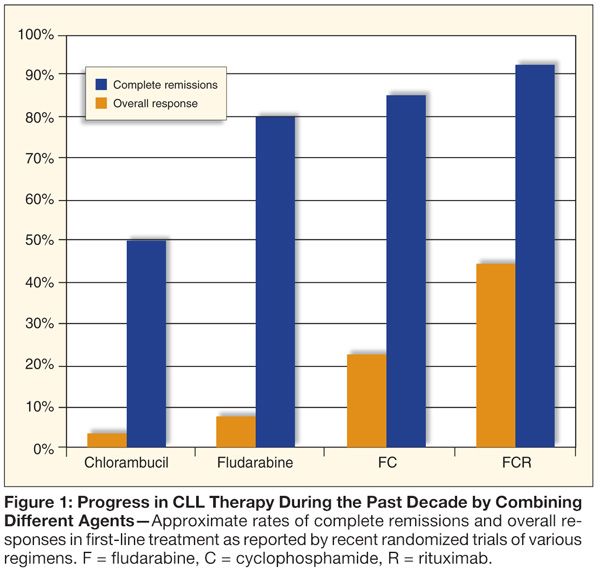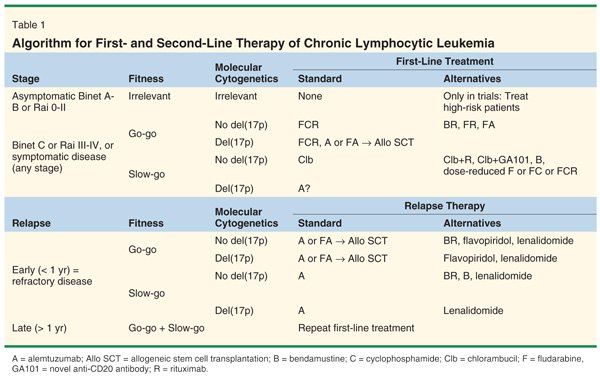New Menus for CLL Treatment
Chronic lymphocytic leukemia (CLL) is a heterogeneous disease with an extremely variable course. Survival after diagnosis can range from months to decades. As the pathogenesis of the disease is increasingly understood, we begin to unfold the molecular patterns that define the different prognostic subgroups and to develop strategies to predict the clinical course.
Chronic lymphocytic leukemia (CLL) is a heterogeneous disease with an extremely variable course. Survival after diagnosis can range from months to decades. As the pathogenesis of the disease is increasingly understood, we begin to unfold the molecular patterns that define the different prognostic subgroups and to develop strategies to predict the clinical course. In addition, a number of more potent treatment modalities have been designed during the past 10 years that allow us to achieve complete remissions in almost 50% of patients and to obtain a treatment-free time of more than 5 years (Figure 1).

Fludarabine, bendamustine (Treanda), and two monoclonal antibodies, alemtuzumab (Campath) and rituximab (Rituxan), have been approved by the European and/or American regulatory agencies as novel therapies for CLL. Several novel monoclonal antibodies targeting CD20, CD23, or CD40, as well as drugs designed to interfere with proteins regulating the cell cycle, apoptotic machinery, or leukemic microenvironment (eg, flavopiridol, oblimersen [Genasense], ABT-263, or lenalidomide [Revlimid]) are currently being tested in clinical trials.
Furthermore, the increased experience with reduced-intensity allogeneic progenitor cell transplantation allows offering this option to physically fit patients. In addition, new prognostic markers that may influence therapeutic decisions have been identified. Novel chemoimmunotherapies have the the potential to eradicate CLL beyond the detection level (minimal residual disease, or MRD). The review by Matthew Kaufman, Jason Rubin, and Kanti Rai gives a comprehensive update on these recent developments.

Practical Algorithm
The major issue for the practicing hematologist/oncologist is the translation of these developments into a practical, therapeutic concept. This is highly relevant, because CLL is the classical leukemia of the elderly that often requires tailoring the treatment according to the patients’ fitness and ability to tolerate more toxic combination therapies. Today, the choice of CLL therapy becomes increasingly personalized: Thus, the selection of appropriate therapies requires a high degree of professional experience. Therefore, I wish to propose my personal algorithm (Table 1) for the selection of the best treatment option based on three potentially relevant points to consider:
(1) The physical condition (fitness and comorbidity) of the patient, which is independent of calendar age.
(2) The prognostic risk of the leukemia as determined by genetic and other prognostic factors.
(3) The Rai or Binet stage of the disease.
Patients with early-stage disease (Binet A/B, Rai 0–II) without symptoms usually do not require therapy. Early treatment is currently tested in clinical trials for patients at high risk. In patients with advanced (Binet C, Rai III-IV) or active, symptomatic disease, treatment should be initiated. In this situation, patients need to be evaluated for their physical condition (or comorbidity). To patients in good physical condition (“go-go”), as defined by a normal creatinine clearance and a low score on the cumulative illness rating scale (CIRS),[1] an FCR combination therapy should be offered. Patients with relevant comorbidity (“slow-go”) may be offered either chlorambucil (Leukeran) or a dose-reduced fludarabine-containing regimen for symptom control.
Patients with symptomatic disease and with del(17p) or p53 mutations respond poorly to fludarabine or FC, and show a response rate of approximately 50% to alemtuzumab monotherapy or combination therapy, as well as to FCR, but these responses usually have a short duration of a few months to 1.5 years.[2-4] Therefore, these patients should be treated within experimental protocols, and it should be proposed that they undergo an allogeneic stem cell transplant whenever possible. Patients with del(17p) may respond to alemtuzumab monotherapy or combination therapy.[5]
Second-Line Treatment
For second-line treatment, the first-line treatment may be repeated if the duration of the first remission exceeds 12 months (or, with modern chemoimmunotherapies, 24 months). The choice becomes more difficult and limited in treatment-refractory CLL (as defined by an early relapse within 6 months after the last treatment) or in cases with the chromosomal aberration del(17p). In principle, the initial regimen should be changed. The following options exist:
• Alemtuzumab alone or in combination[6,7]
• Flavopiridol (in clinical trials)[8]
• Lenalidomide (if available or in clinical trials)[9]
• Allogeneic stem cell transplantation with curative intent.[10]
The choice of one of these options depends on the fitness of the patient. According to recent consensus group recommendations from the European Group for Blood & Marrow Transplantation (EBMT), physically fit patients with refractory CLL or with del(17p) should be offered an allogeneic transplantation, since their prognosis has remained extremely poor with conventional therapies.[10]
Finally, and in full agreement with the authors of this review, it is important to emphasize that CLL patients should be treated within clinical trials whenever possible. The choice of treatment options demands the continued optimization of our current therapeutic algorithm for this uncurable disease.
References:
1. Extermann M, Overcash J, Lyman GH, et al: Comorbidity and functional status are independent in older patients. J Clin Oncol 16:1582-1587, 1998.
2. Hallek M, Fingerle-Rowson G, Fink A-M, et al: Immunochemotherapy with fludarabine (F), cyclophosphamide (C), and rituximab (R) (FCR) versus fludarabine and cyclophosphamide (FC) improves response rates and progression-free survival (PFS) of previously untreated patients (pts) with advanced chronic lymphocytic leukemia (CLL) (abstract 325). Blood 112, 2008.
3. Hillmen P, Skotnicki AB, Robak T, et al: Alemtuzumab compared with chlorambucil as first-line therapy for chronic lymphocytic leukemia. J Clin Oncol 25, 5616-5623, 2007.
4. Stilgenbauer S, Zenz T, Winkler D, et al: Subcutaneous alemtuzumab in fludarabine-refractory chronic lymphocytic leukemia: Clinical results and prognostic marker analyses from the CLL2H study of the German Chronic Lymphocytic Leukemia Study Group. J Clin Oncol 27:3994-4001, 2009.
5. Stilgenbauer S, Dohner H: Campath-1H-induced complete remission of chronic lymphocytic leukemia despite p53 gene mutation and resistance to chemotherapy. N Engl J Med 347:452-453, 2002.
6. Elter T, Borchmann P, Schulz H, et al: Fludarabine in combination with alemtuzumab is effective and feasible in patients with relapsed or refractory B-cell chronic lymphocytic leukemia: Results of a phase II trial. J Clin Oncol 23, 7024-7031, 2005.
7. Rai KR, Freter CE, Mercier RJ, et al: Alemtuzumab in previously treated chronic lymphocytic leukemia patients who also had received fludarabine. J Clin Oncol 20:3891-3897, 2002.
8. Byrd JC, Lin TS, Dalton JT, et al: Flavopiridol administered using a pharmacologically derived schedule is associated with marked clinical efficacy in refractory, genetically high-risk chronic lymphocytic leukemia. Blood 109, 399-404, 2007.
9. Chanan-Khan A, Miller KC, Musial L, et al: Clinical efficacy of lenalidomide in patients with relapsed or refractory chronic lymphocytic leukemia: Results of a phase II study. J Clin Oncol 24:5343-5349, 2006.
10. Dreger P, Corradini P, Kimby E, et al: Indications for allogeneic stem cell transplantation in chronic lymphocytic leukemia: The EBMT transplant consensus. Leukemia 21:12-17, 2007.
2 Commerce Drive
Cranbury, NJ 08512
All rights reserved.